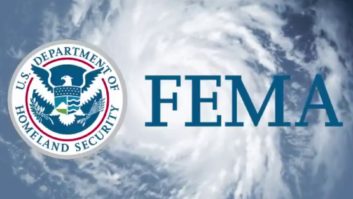
Jim Charlong works his Morse code key. All photos courtesy of Parks Canada.
GLACE BAY, Nova Scotia — On Dec.17, 1902, from the seaside Table Head radio station at Glace Bay, Nova Scotia, Guglielmo Marconi made the first radio transmission from North America to Europe.
This Morse code transmission completed his tests. A year before, Marconi had transmitted Morse code successfully from Poldhu, Cornwall in the U.K. to a receiving station on Signal Hill, Newfoundland.
The Morse code signals were blasted from Table Head using an awe-inspiring 35-kW spark-gap transmitter. They were emitted at 500 kHz from a square vertical curtain array antenna, strung between four massive wooden 64-meter towers. This was brute-force broadcasting, using the same engineering paradigm that chose monstrous Saturn V rockets to take men to the moon decades later.
LIFELONG PASSION
A few years later, Marconi moved the Table Head towers to a site he deemed more suitable for commercial ship-to-shore wireless traffic. But the tower’s concrete foundations still remain at this windswept rock plain, which is now home to the Marconi National Historic Site of Canada (www.pc.gc.ca/marconi).

Jim Charlong at his radio shack.
Operated by Parks Canada, the Marconi site features a museum with a model of the original transmission structure, a historical multimedia display and tour — and Jim Charlong, who keeps the site’s Morse code broadcast legacy alive and on the air.
Charlong is a dedicated Morse code operator with 50 years’ experience under his “fist” — fist being a ham radio term that describes the signature speed and style of an operator’s key-tapping skills. Since the Marconi museum opened in July 1989, he has volunteered as its resident Morse code radio operator. From his “radio shack” inside the museum, Charlong regularly communicates with other Morse code operators around the world.
“I’m here from 10 a.m. to 6 p.m., seven days a week, from the time the museum opens on June 1to when it closes on Sept. 15,” said Charlong. “For a Morse code operator, this is heaven. I’m living the dream.”
When Jim Charlong was growing up in rural Nova Scotia in the 1950s and ’60s, Morse code was a requirement for anyone wanting to obtain an amateur radio (ham) voice license.

A view of the Table Head transmission site today.
However, even though he learned the code and earned the right to broadcast his voice at age 16, Charlong has stuck to the key. “I have no use for the microphone,” he said. “Morse code is a better medium, because it can go places the voice can’t.”
Charlong is correct: The dot-and-dashes used in Morse code transmission are much easier to pick out amidst RF static and lightning crashes that make voice transmission unintelligible.
VAS HOME
In recent years, the Morse code requirement has been dropped from the ham license. But there are still Morse code hams on the airwaves. One can hear their rapid code streaming from the speaker of Charlong’s Kenwood TS-2000 transceiver. It sits on a shelf with various vintage ham radio transceivers at the museum’s radio shack.
In truth, the museum’s shack is a spacious part of the exhibition hall. It is dominated by the letters “VAS” on the wall. They stand for “Voice of the Atlantic Seaboard,” the call sign of Marconi’s Nova Scotia radio station until it ended service in 1946.

The Marconi museum with Charlong’s multiband antenna
Thanks to Charlong, VAS is on-air and heard around the globe. The proof can be found on a world map mounted beside the VAS logo. The map is studded with colored pins, to mark the places Charlong has reached. There are pins everywhere.
Of course, Charlong’s range is boosted thanks to an excellent multiband antenna, which sits on the museum’s outdoor tower (with rotor head), plus a 100-W transmitter to kick his signal up into the ionosphere, which it bounces around to the other side of the world and back. (All the equipment is maintained by the Sydney Amateur Radio Club of Nova Scotia, a group of ham enthusiasts to which Charlong belongs.)
Madeleine Harvey is the Marconi National Historic Site’s visitor experience manager. She cannot believe the museum’s good luck in having such a dedicated and qualified volunteer on site.
“The passion Jim has for wireless is infectious,” Harvey said. “It brings it alive for our visitors — and it helps us tell the story of Marconi, a genius who truly was the ‘Wizard of Wireless.’”

The Marconi Museum LIVING TREASURE
In honor of his efforts, Parks Canada gave Charlong a Volunteer Recognition Award in 2011. Yet no matter how much he appreciated the recognition, Charlong sees his real reward as being allowed to keep VAS alive — and having daily access to a quality of equipment and transmission power not available at his seniors’ residence in nearby Sydney.
“The romance of Morse code and wireless has never faded for me,” said Charlong. “Being able to send and receive it from the site of Marconi’s first North American transmission — literally working where he and his operators made broadcast history? It just doesn’t get any better than this.”
James Careless reports on the industry for Radio World from Ottawa, Ontario.







